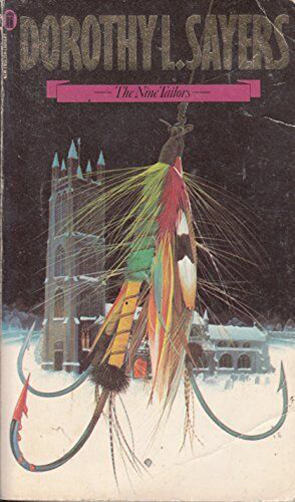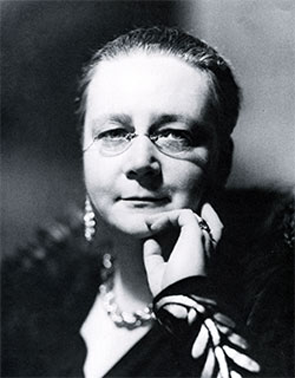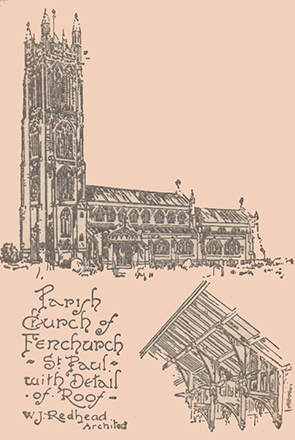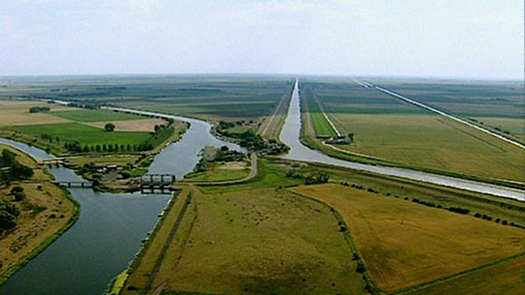The bells gave tongue: Gaude, Sabaoth, John, Jericho, Jubilee, Dimity, Batty Thomas and Tailor Paul, rioting and exulting high up in the dark tower, wide mouths rising and falling, brazen tongues clamouring, huge wheels turning to the dance of the leaping ropes. Tin tan din dan bim bam bom bo--tan tin din dan bam bim bo bom--tan dan tin bam din bo bim bom--every bell in her place striking tuneably, hunting up, hunting down, dodging, snapping, laying her blows behind, making her thirds and fourths, working down to lead the dance again. Out over the flat, white wastes of fen, over the spear-straight, steel-dark dykes and the wind-bent, groaning poplar trees, bursting from the snow-choked louvres of the belfry, whirled away southward and westward in gusty blasts of clamour to the sleeping counties went the music of the bells--little Gaude, silver Sabaoth, strong John and Jericho, glad Jubilee, sweet Dimity and old Batty Thomas, with great Tailor Paul bawling and striding like a giant in the midst of them. Up and down went the shadows of the ringers upon the walls, up and down went the scarlet sallies flickering roofwards and floorwards, and up and down, hunting in their courses, went the bells of Fenchurch St. Paul.
The Nine Tailors, page 32, the start of the New Year peal
The thing that strikes you most about The Nine Tailors as you read it is the sense of place. The descriptions of the drainage dykes across the Fens could be taken as long winded background, but they are important to the story. Sayers grew up in the Fens, where her father was a rector. Her knowledge of the landscape is apparent in the book. The next thing that strikes you is the emphasis on bell ringing (or campanology). If you take away the Fens and the bells, there is no plot and no story.
The plot is complex, linking a mutilated body found in the church graveyard to a jewel robbery that occurred twenty years earlier. However, it is slow to get going. I liked the slow pace and found it relaxing to ease into the story, but people in search of an exciting mystery may find the first quarter or so of this book a bit of struggle. The story opens with Lord Peter Wimsey crashing his car into a drainage dyke near the village of Fenchurch St Paul in East Anglia on New Year’s Eve. There’s a snowstorm and the car is stuck in the ditch for the night, so he takes refuge at the local rectory. But it’s not a peaceful night, as the rector is an enthusiastic campanologist and has planned a nine-hour peal on the church’s circle of eight bells to welcome in the new year. When it looks like this ‘treat’ will have to be cancelled when a bellringer comes down with flu, Wimsey steps in to save the day, and spends his night ringing one of the bells. The first few chapters of the story concern themselves with bell ringing, and the history and architecture of the church, both of which the rector shows himself willing to talk about for hours.
Early next morning, the rector is summoned to the local squire’s house to administer the last rites to the squire’s wife, Lady Thorpe. While he’s away, Wimsey hears the story of the Thorpe misfortunes which started when a valuable emerald necklace was stolen twenty years ago. The thieves were captured but the necklace was never recovered. Eventually, Wimsey’s car is retrieved, repaired, and he proceeds on his way. Several months later the rector summons him back to the village, asking for his help again. Sir Henry Thorpe has also now died, and when Lady Thorpe’s grave is opened for him to buried with her, a mutilated corpse is found on top of the coffin. Its hands have been removed and the face so badly beaten that no one can identify it. This is where the story starts to pick up pace, as Wimsey works with the local police to solve the mystery of the man’s identity and that of his murderer.
From this point we get a well-plotted murder, with plenty of twists, and mis-identifications and lots of suspects. Several of the villagers have secrets that they would prefer remain hidden, but Wimsey gradually sorts all of the divergent strands into a coherent solution. And all the time he is in the village, the eight bells are always in the background, important to both the routine life of the villagers and to providing the key to the mystery.
This is a beautifully crafted mystery that rewards a reader who takes the time to read it slowly and immerse themselves in the world of an isolated village where the local church is important to daily life. It’s a very human story, where Wimsey, as the main detective, begins to identify with the people he is investigating and becomes part of their life. This was a reread for me, but I loved returning to the story and to the world of church bells and ringing peals on the church bells. Well worth a read.
 RSS Feed
RSS Feed Facebook
Facebook Instagram
Instagram YouTube
YouTube Subscribe to our Newsletter
Subscribe to our Newsletter







No one has commented yet. Be the first!